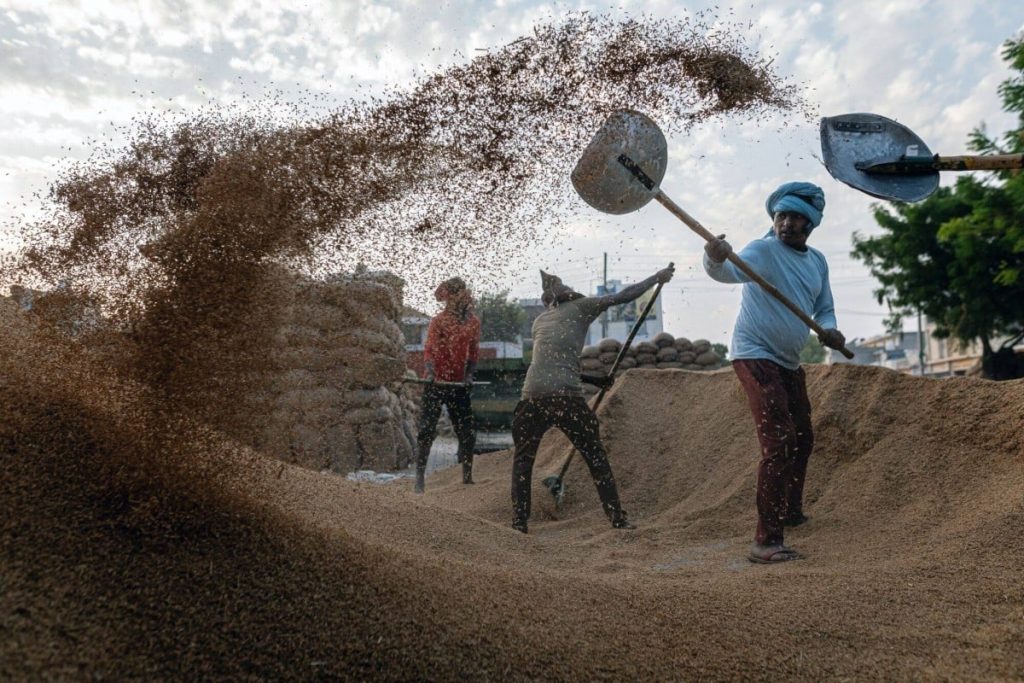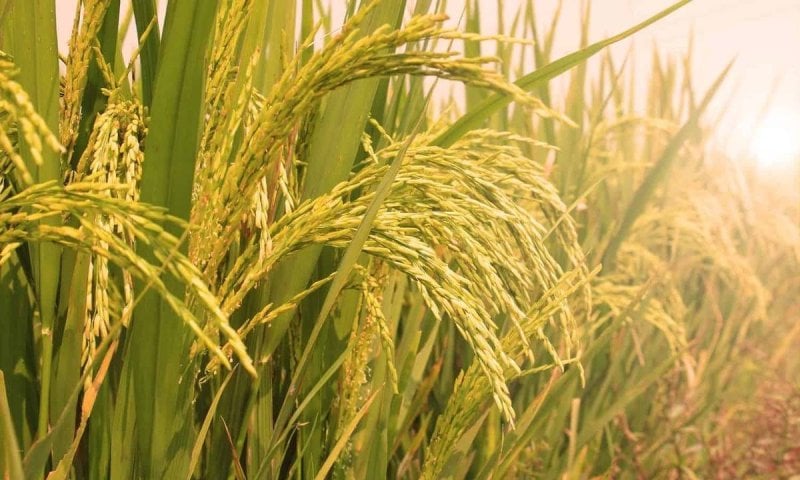Tags
Global rice shortage looms as top exporter India’s supply woes worsen amid Red Sea attacks
- Exports of India’s premium basmati rice dropped by up to half this month from a year ago as freight rates doubled after a series of ship attacks in the Red Sea
- India’s lower rice shipments are likely to affect the Philippines and Malaysia in Southeast Asia and Nigeria, Ivory Coast and Senegal in West Africa, analysts say

Workers shovel harvested rice onto a pile to dry at a wholesale market in Narvana, India. India is the world’s top rice exporter, accounting for around 40 per cent of global rice shipments and exporting to more than 150 countries. Photo: Bloomberg
Global rice shortages are set to worsen, as India’s exports of premium varieties encounter fresh hurdles due to a surge in freight costs amid the Israel-Gaza war – and domestic shortages hit shipments of other types of rice.
Exports of premium Indian basmati rice last month were half of what they were a year ago, with traders blaming freight rates that have doubled following a series of attacks on commercial ships by Iran-backed Houthi militants.
Tensions have surged in the Middle East, with Houthi forces striking US and other targets in the Red Sea, disrupting global shipping. On Monday, Hamas fired its first volley of rockets into Israeli cities in weeks, proving it still had the capability to launch them after nearly four months of war.
India, the world’s top rice exporter, accounts for around 40 per cent of global rice shipments and exports to more than 150 countries. About 30 per cent of its shipments – or 12 per cent of total global trade – were affected after New Delhi in July banned exports of white rice and broken varieties, barring exceptions to address other nations’ food-security concerns.
“The problem in the Red Sea is escalating. A quick solution is not forthcoming, despite America’s intervention to stop Houthi attacks. People are in a wait-and-watch mode and are only exporting limited quantities,” said Vijay Setia, former president of the All India Rice Exporters’ Association.
The Middle East is an important market for India’s basmati rice exports. But Setia said the time it took to ship cargo from India to the region had increased by three or four weeks following the upsurge of violence in the Red Sea.
Indian basmati prices currently sit at around US$950 to $1,800 per tonne, traders say.

Meanwhile, the price of exported parboiled rice – which is partially boiled in the husk before sale – from India skyrocketed to a record high of between US$533-US$542 per tonne this week on limited supplies and steady demand from Asian and African buyers.
Purchases from rice farmers by the state-run Food Corporation of India have hardly left any stocks for private traders, who say more supplies are likely to be kept at home to rein in domestic prices as the nation prepares to head to the polls later this year. Food inflation has historically been a key issue for voters in India.
India’s exports of non-basmati varieties are also being affected by the limited quantities available to private traders, as well as the long shipping times and more expensive freight costs to parts of Africa and other places, said Prem Garg, national president of the Indian Rice Exporters Federation.
High freight costs have also resulted in disputes as exporters push to negotiate their contracts with buyers.
“Old contracts with buyers are being disputed. Many people want to cancel their orders,” Garg said, adding that the cost of booking a single container on ships to Africa had tripled to US$4,000.
The logistics nightmare has had less of an impact on Thailand and Vietnam, the world’s second- and third-ranked rice exporters, because they send fewer shipments via the Middle Eastern hotspot, traders say.
“India and Pakistan’s exports are more affected. Thailand and Vietnam exports are in a lull period and will pick up after Ramadan [expected to end on April 9],” said a Thailand-based rice trader who asked not to be identified.
Indian rice is usually cheaper than comparable Thai and Vietnamese varieties and is preferred in parts of Africa, the trader said. Both Thailand and Vietnam also export greater quantities within Asia, such as to the Philippines.
Vietnam’s benchmark 5 per cent broken rice is being offered at around US$630 per metric tonne, down from US$653 a week ago. Indian varieties usually sell for around US$100 per tonne less, traders say.

Rice harvesting has just begun in Vietnam and Thailand and is expected to peak in March. Indian rice is harvested from October to November, and its supplies peak between December and January.
Oil prices are another concern. Benchmark Brent crude futures nudged above US$80 per barrel last week following an escalation of hostilities by Houthi rebels, including an attack on a fuel tanker on Friday. Slow output cuts by Opec producers have kept prices steady so far, with supplies remaining robust despite logistics issues.
Slow output cuts by Opec producers have kept prices steady as supplies to world markets have been robust despite logistic issues.
Looming rice shortages could also be exacerbated by lower production in China and Indonesia in particular, said Greg Evans, a food and agriculture analyst at S&P Global Commodity Insights.
“China’s production was significantly cut on a reduction in area. Imports, however, will not likely be used to make up the shortfall, and China will instead see reduced consumption and a drawdown of stocks. In Indonesia, the planting season was delayed due to dry weather from El Nino, and there is likely to be another year of elevated imports, raising international prices and increasing competition for other buyers,” he said.
Impact of India’s elections, El Nino
In a food security report dated January 27, the World Bank said rice prices had increased by 4 per cent from its last update in mid-December, and up by 39 per cent year-on-year.
Dry conditions due to El Nino – a weather phenomenon marked by irregular rainfall patterns – are threatening key producing regions, but an easing of India’s export ban on certain rice varieties could stabilise prices, the World Bank said.
Industry executives are not anticipating India to ease up on rice exports until after the elections, tentatively scheduled between April and May. The June-September monsoon that typically brings 70 per cent of the country’s annual rainfall is also a factor.
In Southeast Asia, India’s lower rice shipments are likely to affect the Philippines and Malaysia the most, according to Ravi Khetarpal, executive secretary of Asia-Pacific Agricultural Research Institutions, who added that Nigeria, Ivory Coast and Senegal in West Africa would also be hit hard.
Bad weather in other rice producing nations like China and Pakistan, as well as the Israel-Gaza and Ukraine wars, have also contributed to supply woes, he said.

The Northern Hemisphere, home to many of the world’s major rice producers, is likely to be troubled by El Nino throughout the April to June period that constitutes the main sowing season for rice across Asia, Khetarpal said.
Thailand and Vietnam may look to fill the supply vacuum left by India as they are the next largest exporters, industry insiders say.
“The severity [of the shortage] is expected to last for a reasonable period that can’t be predicted” because of the ongoing wars and climate change, Khetarpal said, adding that nations should look to use climate-friendly techniques to boost output.
He said private-sector traders should also be given a bigger role in rice markets in line with recommendations from the Asian Development Bank.
However, in the short term, it will be hard to plug India’s gap.
“We have seen some increase [in] exports from Thailand, Vietnam and Pakistan, but Southeast Asia has also been affected by El Nino so it’s unlikely that they will completely fill the gap left by India,” said Joseph Glauber, senior research fellow at the International Food Policy Research Institute in Washington.
“I think the world anticipates that India will relax its restrictions after the elections, but if bans are maintained, prices will go higher,” he said.
India’s rice exports declined 47 per cent between August and November from the same period in 2022, Glauber said.
From the most recent trade data through November last year, India’s rice exports to West Africa decreased about 53 per cent, exports to East Africa shrank 57 per cent, and supplies to Middle African nations declined by 80 per cent, he added.
These regions are relying on other suppliers to make up for India’s supply shortfall, but available data shows “it is clear that total rice imports are down”, Glauber said.
“Concern [about food shortages] will grow the longer India continues to restrict exports,” he added.
https://www.scmp.com/week-asia/economics/article/3250769/global-rice-shortage-looms-top-exporter-indias-supply-woes-worsen-amid-red-sea-attacksPublished Date: February 4, 2024






